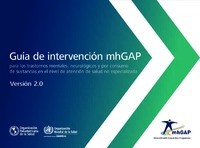Intervention guide mhGAP for mental, neurological disorders and substance use in the level of non-specialized health care. Version 2.0

Mental, neurological and substance (MNS) disorders are very common and represent a large burden of disease and disability around the world. There remains a wide gap between the capacity of health systems and resources, between what is urgently needed and what is available to reduce the charge. Approximately 1 out of every 10 people suffers from a mental health disorder, but only 1% of global health staff provides mental health care services. MNS disorders interfere substantially with the capacity of children to learn and the ability of adults to work properly in the family, at work and in society in general. Recognizing the imperative of providing services to people with disorders MNS and their caregivers, and reduce the gap between available resources and the great need for these services, the Department of Mental Health and substance abuse who got underway in the in 2008 the global programme of action to overcome the gaps in mental health (mhGAP, for its acronym in English). The main objectives of the mhGAP are to strengthen the commitment of Governments, international organizations and other stakeholders increase the allocation of financial and human resources for the care of the MNS disorders and achieve coverage much greater with key interventions in low- and middle-income countries. With these objectives, the mhGAP provides guidance and tools based on the evidence in order to move towards the goals of the Plan of comprehensive action on mental health 2013-2020.
Intervention of this guide was prepared in the year 2010, mhGAP (GI-mhGAP) for mental, neurological disorders and substance use in the level of health care not specialized for the purpose of helping to run the mhGAP. It's a simple technical tool based on the guidelines of the mhGAP, presenting examples of integrated management of disorders MNS priority to applying protocols for clinical decision-making. There is an idea widely disseminated, although erroneous, that all mental health interventions are complex and that they can only be carried out by highly qualified personnel. In recent years, research has shown the feasibility of offer pharmacological interventions and psychosocial level of non specialized care. Since its publication in 2010, the GI-mhGAP has been widely used by a variety of stakeholders, such as ministries of health, academic institutions, NGOs and other philanthropic foundations, as well as researchers, to expand to larger scale mental health services.
The GI-mhGAP version 1.0 is used in more than 90 countries in all who regions and mhGAP materials have been translated into more than 20 languages, including the six official languages of the United Nations. Five years after the initial publication of the Guide, we updated the guidelines mhGAP based on the emerging literature and published a revised version of the guidelines mhGAP in 2015. Now pleased to introduce version 2.0 of the GI-mhGAP, which not only includes these updates, but also extensive comments received from the experiences on the ground, which have been incorporated in order to improve the clarity and usefulness of the Guide. We hope that this guide continues to be a key technical tool to assist persons with disorders MNS worldwide and us closer to the goal of universal health coverage.